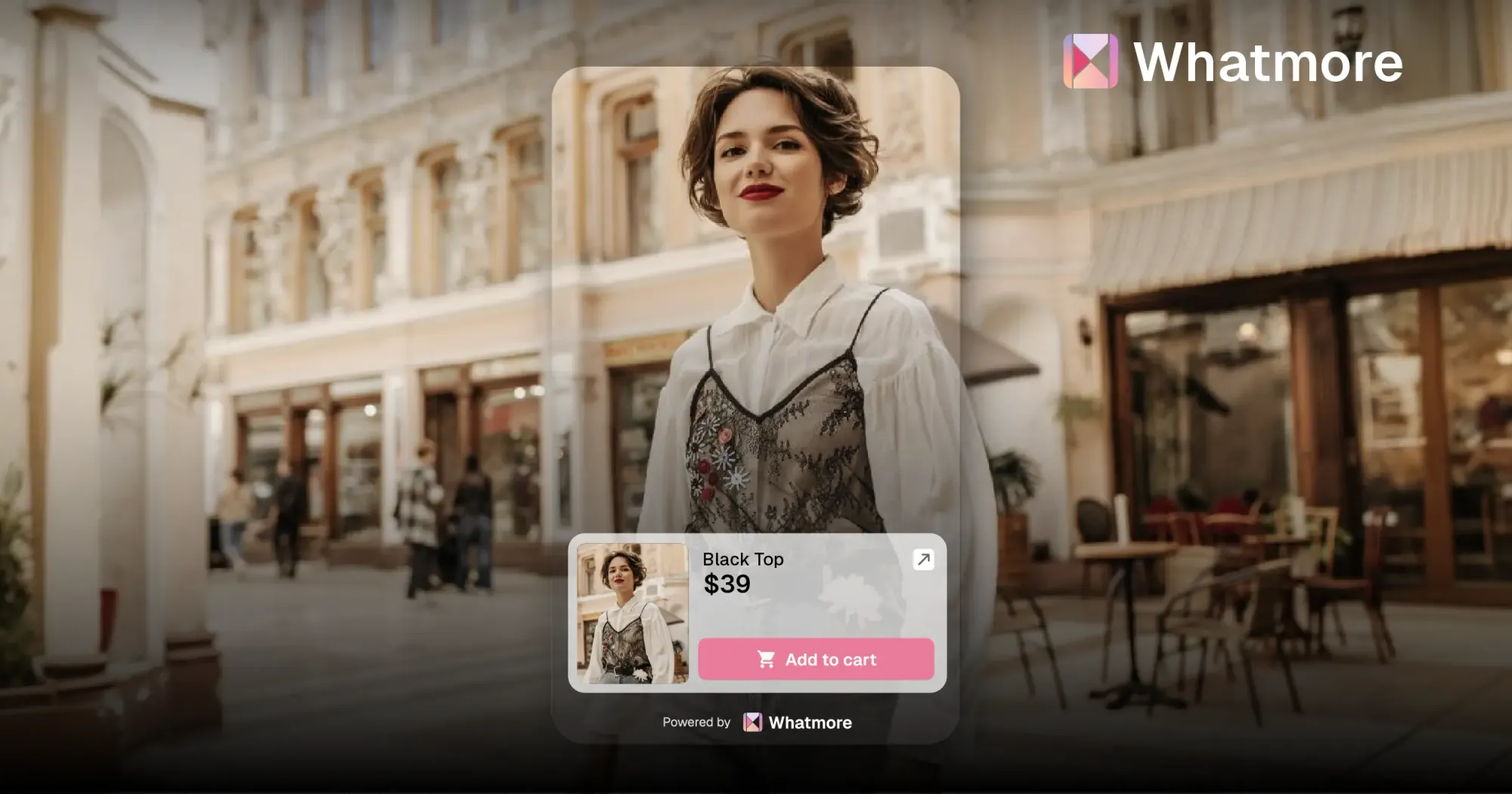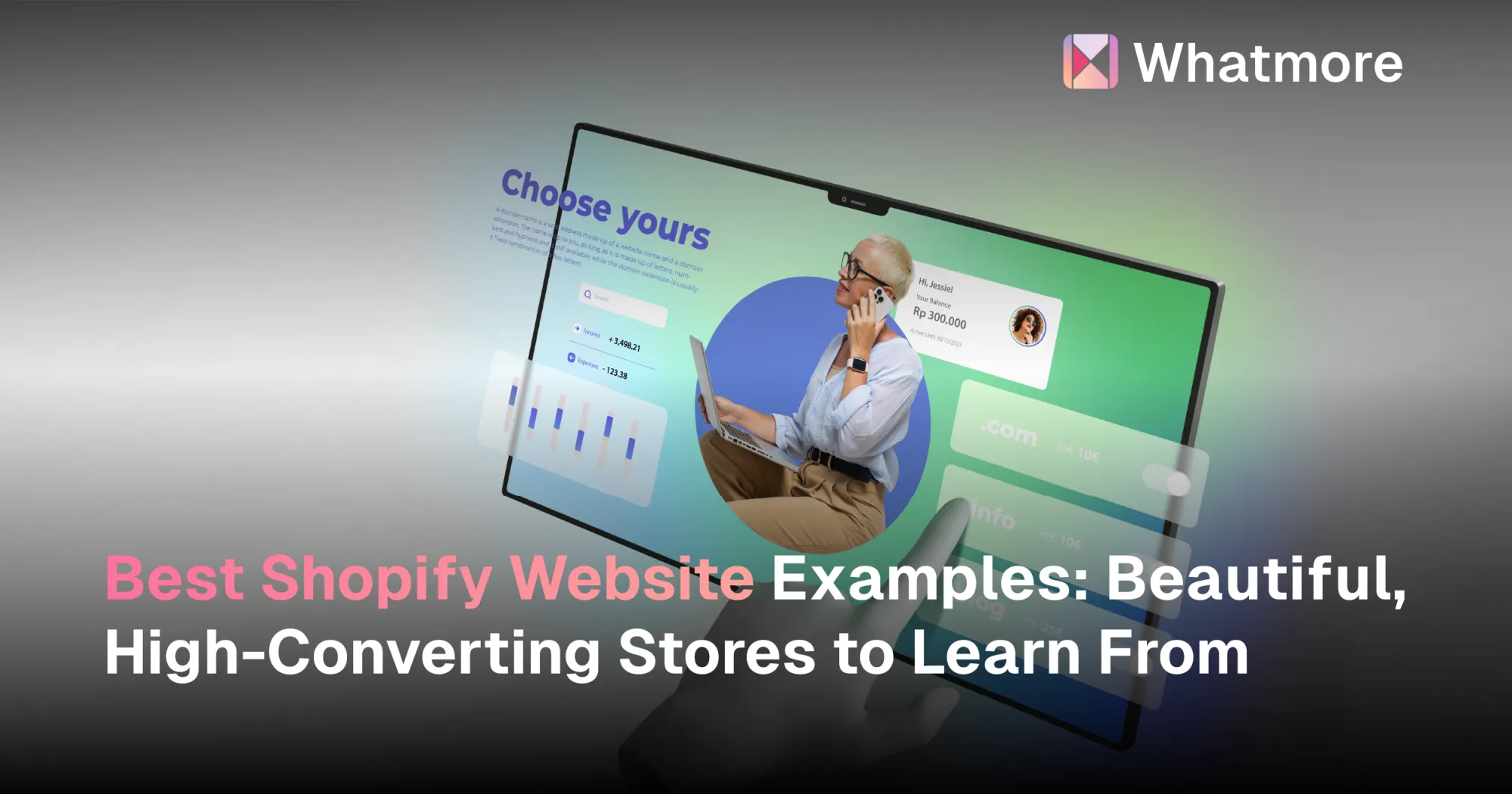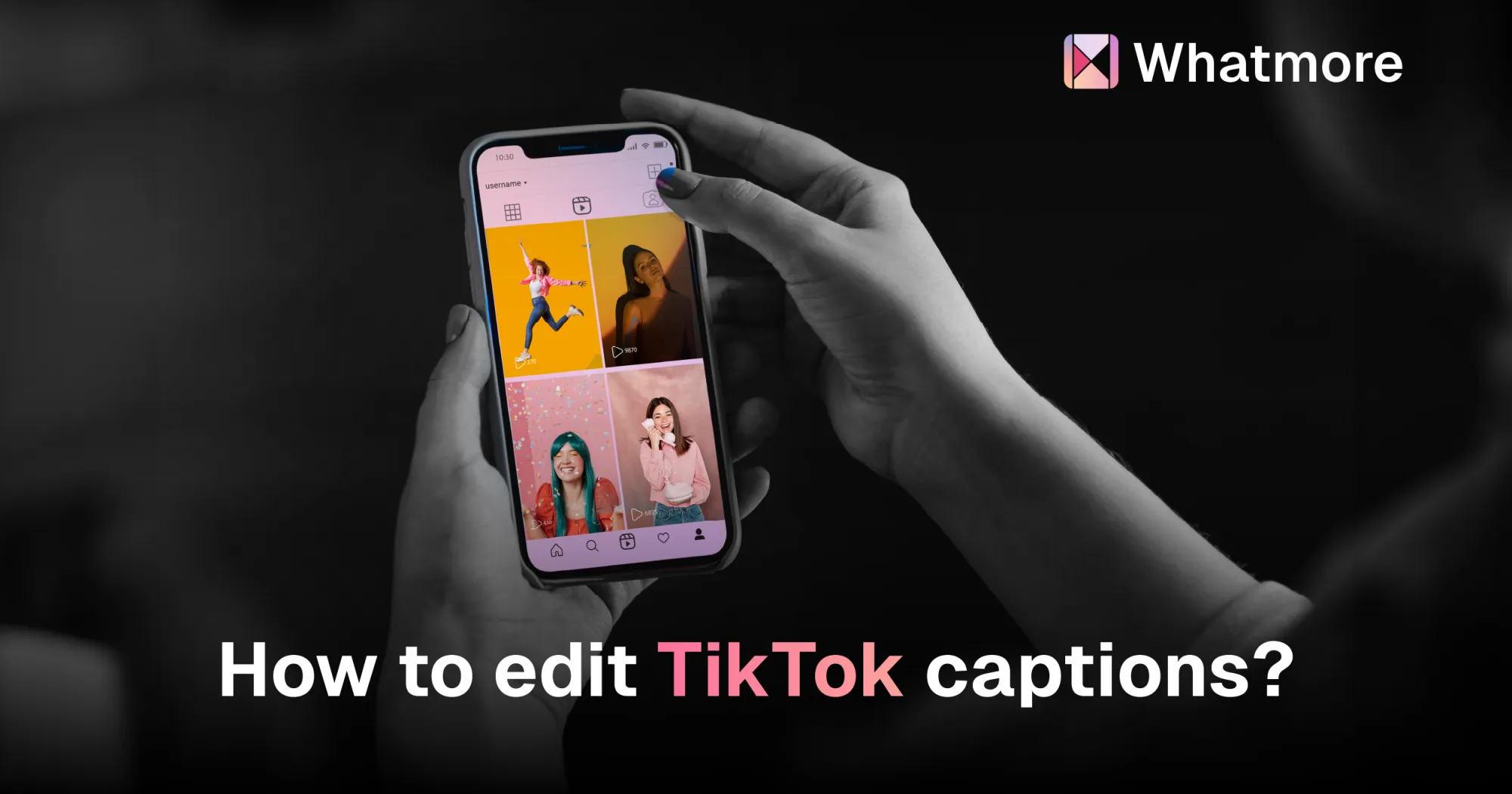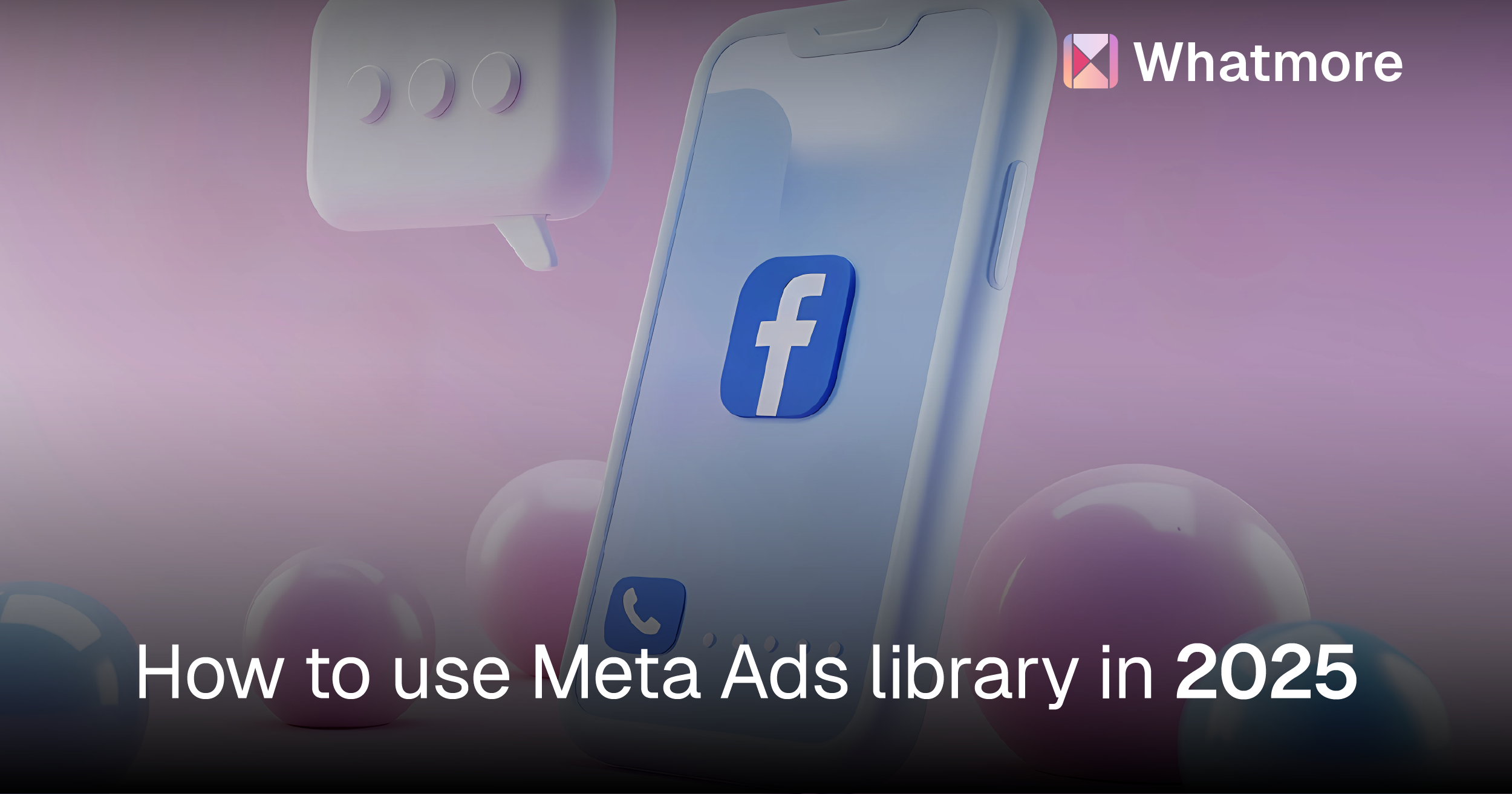You spent hours creating a reel, and the views are already through the roof. But those aren’t turning into sales. If viewers have to search for the product after watching the video, the hassle of switching apps or browsers to make a purchase might cause them to lose interest. And just like that, you’ve lost most of them. But what if you could change that, making it as simple as a click for them to buy right then and there? That’s exactly what a shoppable video helps you achieve.
Shoppable videos are a great way to shop online that blends watching a video with buying products.
What is a Shoppable Video?
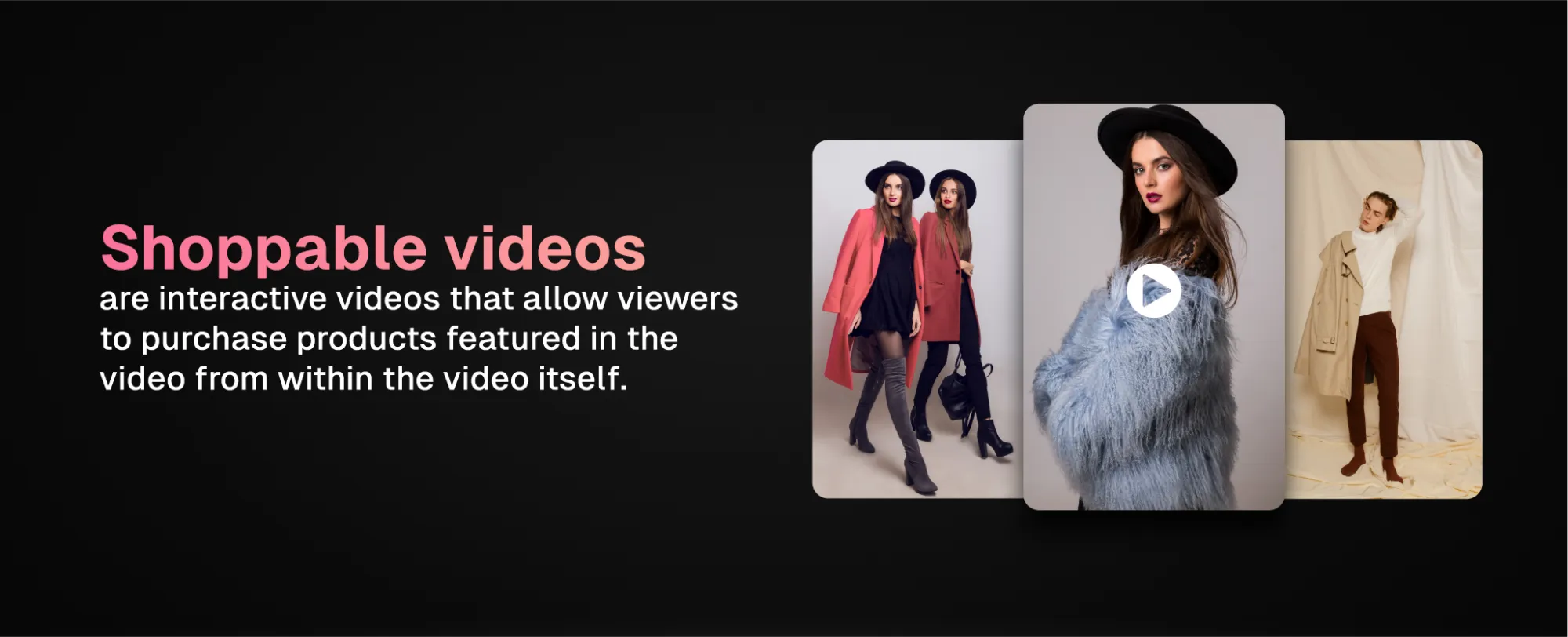
A shoppable video is a form of content that allows viewers to buy the products featured in the video from within the video itself. As the video plays, clickable buttons such as 'Add to Cart' and 'Buy Now' appear, allowing viewers to add featured products to their cart without leaving the video.
This is what they look like.
What does a shoppable video look like
According to Shopify's 2023 Commerce Trends Report,
"shoppable videos significantly lower barriers to conversion, with some companies reporting conversion rates near 30%".
If you're an e-commerce brand, not using shoppable videos is like driving into battle with one arm tied behind the back. Here's what Prabhu, the founder of Whatmore, a shoppable video company, says,
"Consumers are used to interacting with short-form video content on Instagram and TikTok. When you bring that experience to your website and make the videos easy to shop from, your engagement and conversion rate both shoot up."
How does a shoppable video work
Shoppable videos make it super easy to shop without interrupting your experience. These videos are usually short, kind of like the reels you see on Instagram, and they don’t slow down the website or app they’re on. Instead of just showing off your products, these videos let viewers click on items they like and purchase them without leaving the video.
For a good shoppable video, it’s important to create high quality content, use trustworthy video hosting sites and shoppable video tools and add clear CTAs to get the most out of those. Here’s a quick rundown of how it works and what you need to get started with a shoppable video.
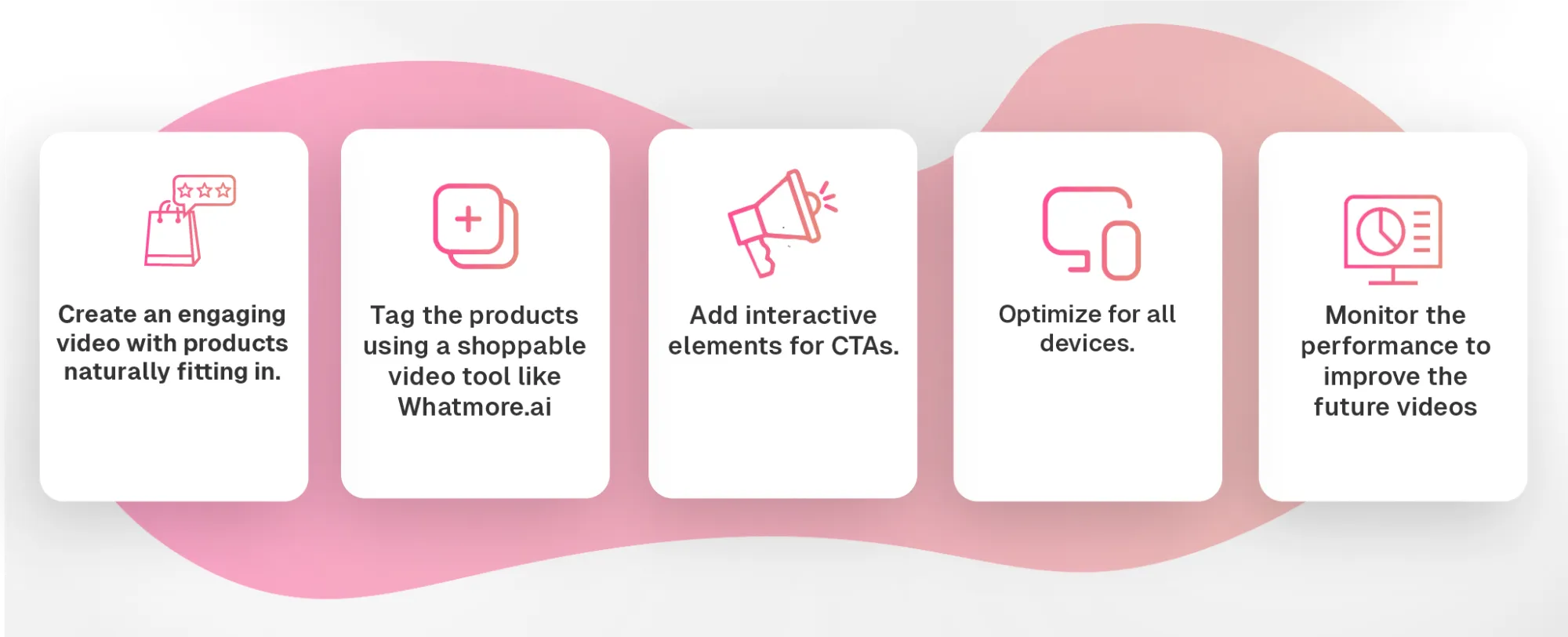
Step 1: Start by creating a video where your products naturally fit into the scene. We have shared an extensive guide about the most engaging types of shoppable video content that you can create.
Step 2: Tag the products featured in the video using a shoppable video tool like Whatmore.ai. These tags are interactive elements, like clickable hotspots or buttons, that appear on the screen when the product is shown. These tags are linked directly to the product’s page on your website.
Step 3: Add interactive elements that show details, allowing viewers to add items to their cart or buy instantly without leaving the video.
Step 4: Optimize for all devices, whether viewers are watching on a smartphone, tablet, or desktop.
Step 5: After your shoppable video is live, monitor which products get the most clicks, how many views convert into sales, and other key metrics. to improve future videos.
Shoppable videos are a powerful way to turn viewer interest into sales by making the purchasing process quick and easy. With the right setup, you can enhance your marketing strategy, engage your audience, and increase your sales—all through the videos you’re already creating.
Adding a shoppable video to your marketing strategy is not just a trend anymore
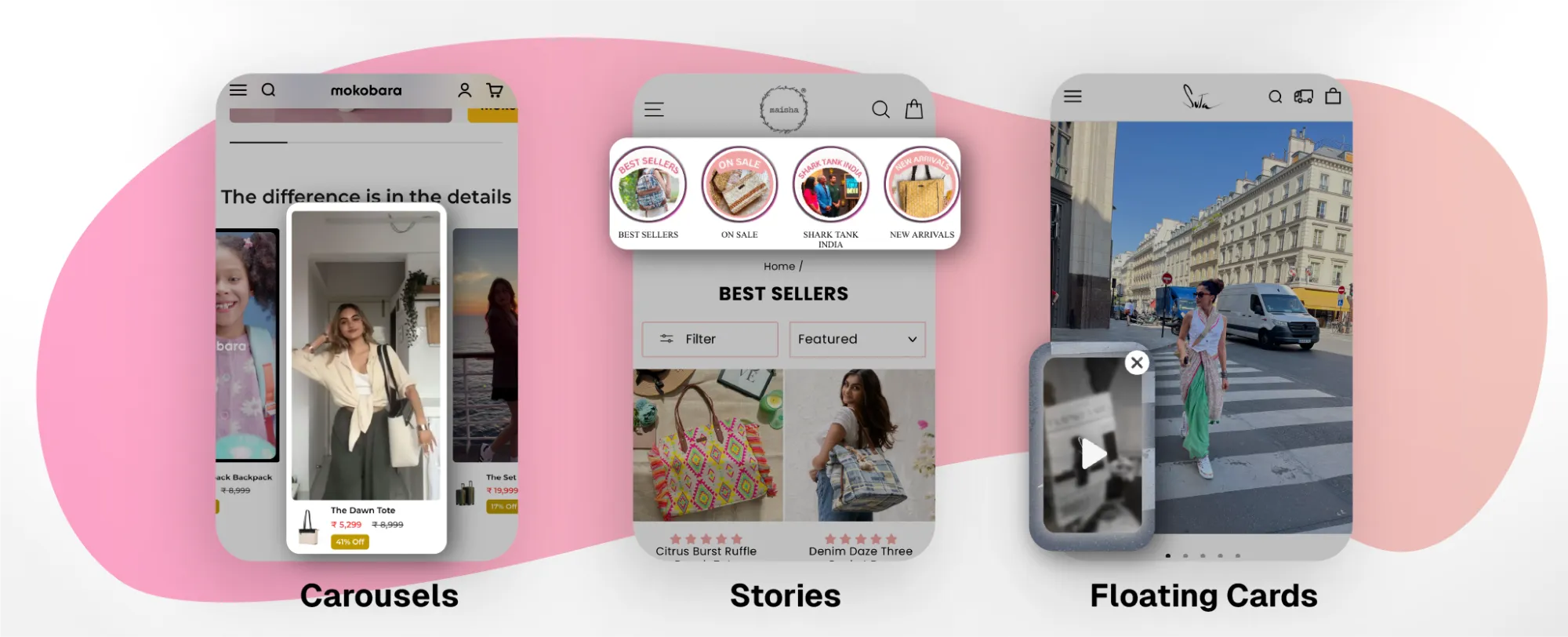
Shoppable videos make online shopping easier and more fun. They let you go from “I like that” to “I’m buying that” in just a few clicks, without having to stop what you’re watching. Whether you’re a small business trying to reach more people or a big brand looking to create a buzz, adding shoppable videos to your website is a smart way to connect with customers and boost sales.
1. Turn viewer excitement into instant sale
A shoppable video captures sales at the exact moment when your customers are most excited about a product. Instead of just watching, they can click and buy on the spot, exponentially increasing your conversion rates.
2. Make shopping effortless for your customers
By letting viewers buy products directly from the video, you create a seamless experience that keeps viewers engaged. No more searching for products or switching apps—everything they need is right there in the video.
3. Capitalize on impulse purchases with a click
Shoppable videos make it easy to capitalize on those spur-of-the-moment buying decisions. With just a click, viewers can move from “I like that” to “I’m buying that,” increasing the likelihood of impulse purchases.
4. Unlock insights with actionable video data
Track exactly how viewers interact with your shoppable videos. Learn which products catch their eye and when they’re most likely to buy, giving you data-driven insights to refine your strategy and boost sales.
5. Maximize your video investment with direct sales
Turn your video content into a direct revenue stream. Shoppable videos ensure that the time and resources you invest in creating engaging content pay off by driving immediate sales.
In a world where everyone’s glued to their screens, building a comprehensive video shopping strategy is a win-win—entertaining for viewers and effective for businesses. By integrating commerce with entertainment, you stay competitive and relevant in a market where video dominates.
How businesses can use a shoppable video in their strategy
Shoppable videos can work for all types of businesses, no matter their size. Here’s how different companies might use them:
1. Small Businesses - Focus on User-Generated Content (UGC)
For small businesses, shoppable videos are a great way to get their products out there without spending a ton of money. By using content created by real customers, like videos of people wearing their clothes or using their products, they can make these videos shoppable. It’s authentic, and it shows potential buyers how the product looks or works in real life. Plus, these videos are easy to share on social media, helping small businesses reach more people.
Here are some other use cases that can benefit small businesses:
a. Showing how to use their product
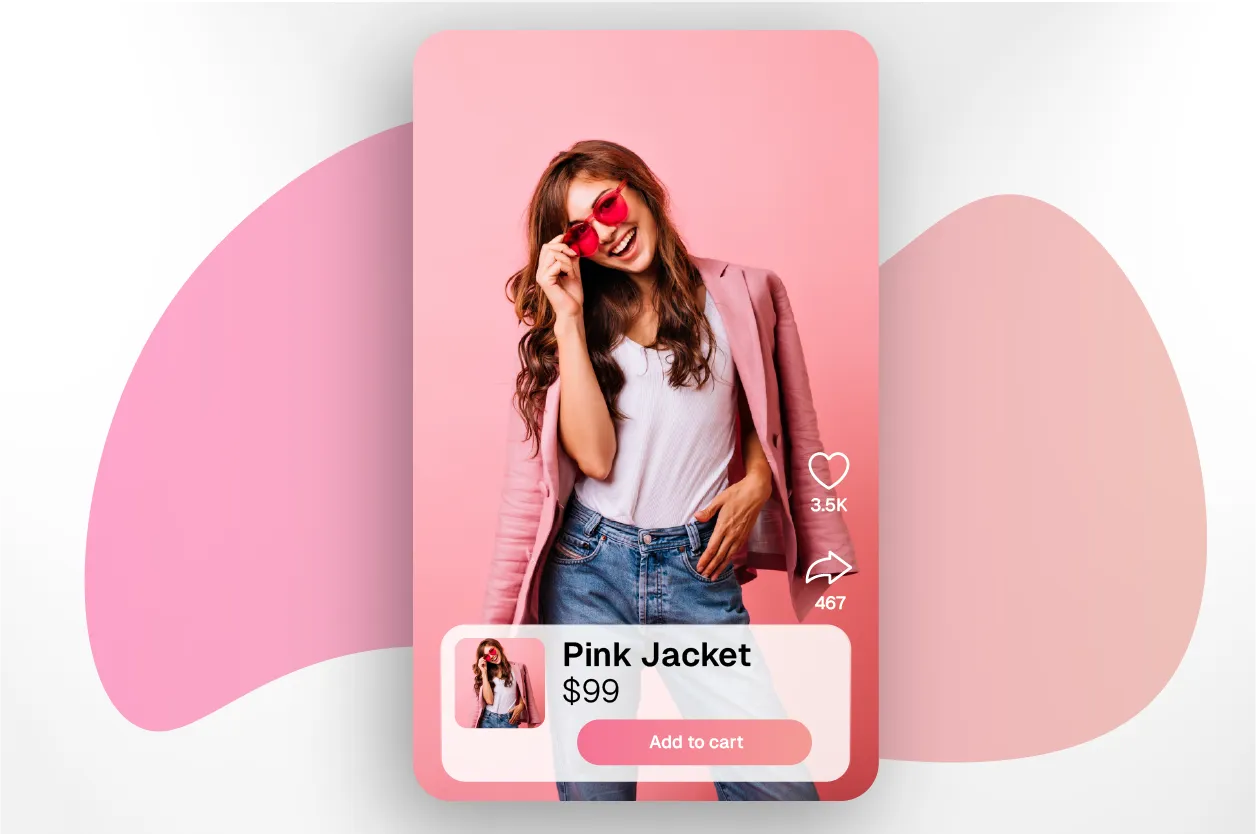
Small businesses can create a shoppable video that teaches how to use their products. For example, a small kitchenware business could create a cooking tutorial featuring their products. As viewers watch the recipe come together, they can click on the specific items used—like a skillet or a set of measuring cups—and purchase them directly from the video.
b. Creating limited-time or seasonal offers
Shoppable videos are a great way to promote limited-time offers or seasonal deals. For example, a small clothing business could create a shoppable video to tell their customers about discounts on certain items. Customers can quickly click to purchase before the deal expires, driving urgency and increasing sales.
c. Introducing new products
When launching a new product, small businesses can use shoppable videos to create buzz and make it easy for customers to purchase the item immediately. For example, a small skincare brand could produce a video highlighting the benefits of a new serum, allowing viewers to buy it directly from the video without having to move to another page.
d. Behind-the-Scenes content
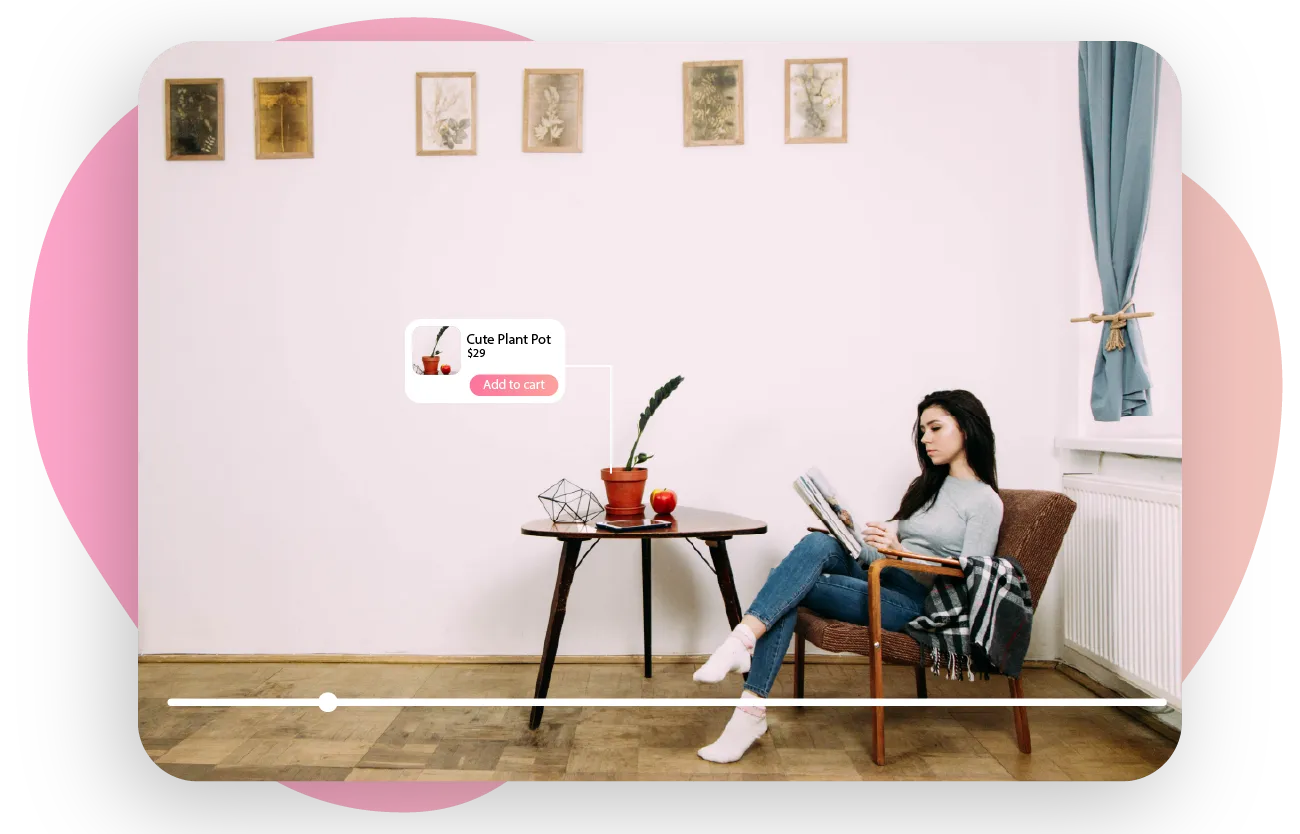
Small businesses can connect closely with their customers by creating shoppable videos that offer a behind-the-scenes look at how their products are made. This is especially effective for handmade or artisanal goods. As viewers watch the process, they can click on the featured products to purchase them, connecting the story of the product with the opportunity to buy it.
e. Storytelling through lifestyle videos
Lifestyle videos that tell a story can be made shoppable, allowing small businesses to connect with customers on an emotional level while showcasing their products. For example, a small outdoor gear company could create a video of an adventure trip, with all the gear used in the video tagged and available for purchase.
f. Cross-promoting products
Shoppable videos allow small businesses to cross-promote related products effectively. For example, a small home decor shop could create a video featuring a styled room, with different items like throw pillows, wall art, and furniture all tagged for purchase. This allows customers to buy multiple items that work well together.
g. Interactive product catalogs
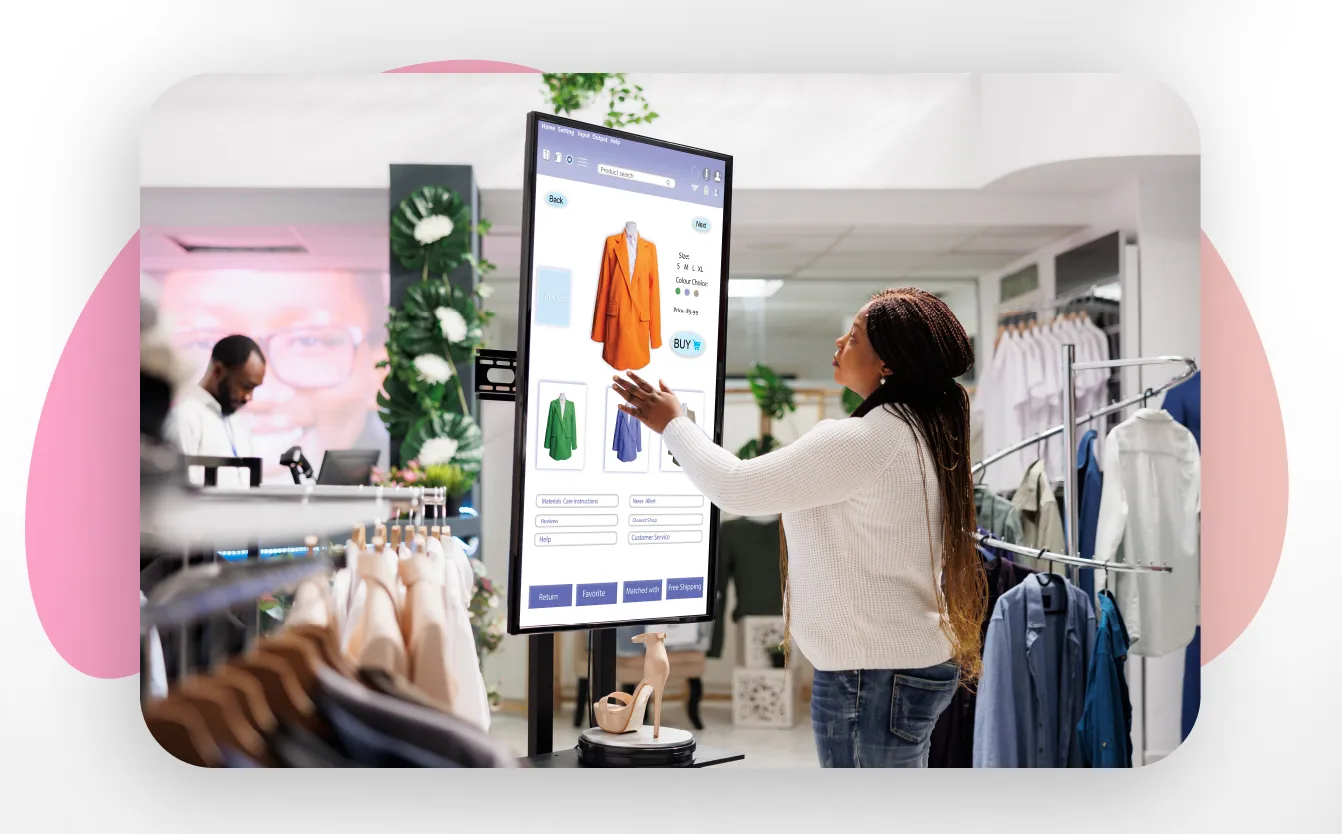
Instead of a static catalog, small businesses can create interactive shoppable videos that act as a dynamic product showcase. Viewers can browse through the catalog, click on items they’re interested in, and make purchases directly from the video, making the shopping experience more engaging and fun.
2. Medium-Sized Businesses - Focus on brand consistency and recall
Medium-sized businesses might have a bit more budget to play with, so they can create more polished videos. Think of those sleek product videos you see from your favorite brands. By adding shoppable elements to these videos, these companies can make it super easy for viewers to buy the products they’re showing. Whether it’s on their website, social media, or in email newsletters, these shoppable videos help turn viewers into customers.
But they still need to balance budgets and find ways to stand out in a competitive market. Shoppable videos can help medium-sized businesses enhance their brand recall, increase conversions, and reach wider audiences. Here are some specific use cases for medium-sized businesses:
a. Elevated product launches
A shoppable video allows customers to immediately purchase the newly launched product directly from the video. This works well for brands looking to create excitement around new items, offering a more immersive launch experience than standard product listings.
b. Brand storytelling and emotional engagement
Medium-sized businesses often have established brand values and stories that they want to communicate to customers. Shoppable videos can tell a compelling story while featuring products in a way that connects emotionally with the viewer. For example, a fashion brand could create a short film featuring how they started the clothing line, allowing viewers to buy the items directly from the video.
c. Interactive product catalogs for multiple product lines
Medium-sized businesses that sell a wide range of products can create interactive shoppable videos that act like dynamic catalogs. Viewers can explore and shop a variety of items, such as clothing collections, furniture ranges, or beauty product lines, all in a single video. This can increase customer engagement and upsell opportunities.
d. Virtual events and live shopping
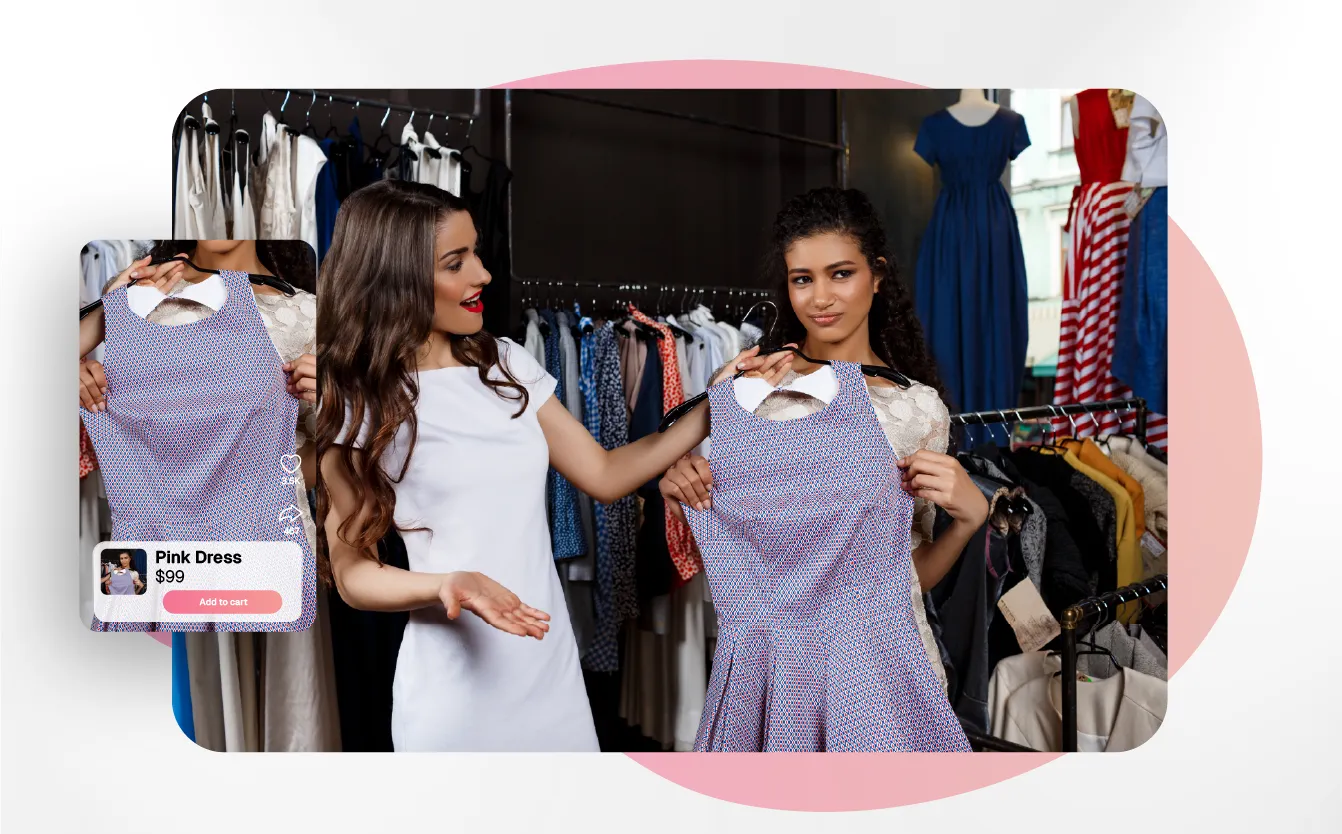
With the resources available to host virtual events, medium-sized businesses can use shoppable videos during live events, product drops, or even webinars. For example, a beauty brand could host a live makeup tutorial with a shoppable video option, allowing viewers to purchase products in real-time while watching the demo.
e. Collaborations with influencers
Medium-sized businesses can collaborate with influencers to increase their reach for the shoppable videos featuring their products. This allows businesses to tap into the influencer’s audience while maintaining a high-quality production. For example, a fitness brand could partner with a popular fitness influencer to create a workout video featuring clickable links to purchase the brand’s apparel and equipment.
f. Enhanced customer loyalty programs
Medium-sized businesses that offer loyalty programs can use shoppable videos that offer exclusive products or early access to sales for members. For example, a beauty brand might release a shoppable video showcasing new skincare products that loyalty members can purchase before the general public.
g. Omnichannel marketing integration
Medium-sized businesses often have a presence on multiple platforms—social media, websites, and even physical stores. Shoppable videos can be integrated across these channels to create a unified shopping experience. For instance, a furniture store can feature a shoppable video on its website, and mention the stores where it is available, making it easy for customers to buy no matter where they interact with the brand.
Shoppable videos give medium-sized businesses a great tool to engage customers and build stronger brand connections. With their ability to invest in higher production quality and leverage multiple channels, medium-sized businesses can use shoppable videos to create a richer, more interactive shopping experience that directly impacts their bottom line.
3. Large Enterprises - Focus on big campaigns
Big companies can go all out with shoppable videos, creating full-blown campaigns that tell a story and connect with viewers on a deeper level. They can produce high-quality, cinematic videos that not only show off products but also make you feel something—whether it’s excitement, nostalgia, or the urge to buy. These videos can be everywhere—on TV, online, and social media—making it easy for people to shop while they watch.
a. High-end commercials with brand storytelling
Large businesses, with much bigger budgets, can create high-production value commercials or short films that align with their brand identity. Sephora creates shoppable videos where viewers can click to buy the makeup products featured in their beautifully crafted, cinematic ad campaigns. This improves the immersive brand experience while making products easy to shop.
Large businesses can implement shoppable videos on a grand scale, using advanced tools and marketing strategies to create memorable customer experiences. Here are some specific use cases of shoppable videos for large-sized businesses:
b. Global product launches
Launching new products worldwide can reach a global audience instantly using shoppable videos. For example, Apple could use shoppable videos to highlight the features of a new iPhone, allowing viewers from different countries to pre-order directly through the video, in their respective regions. The videos could be tailored to different markets with language-specific features, all while offering a seamless shopping experience.
c. Personalized video ads
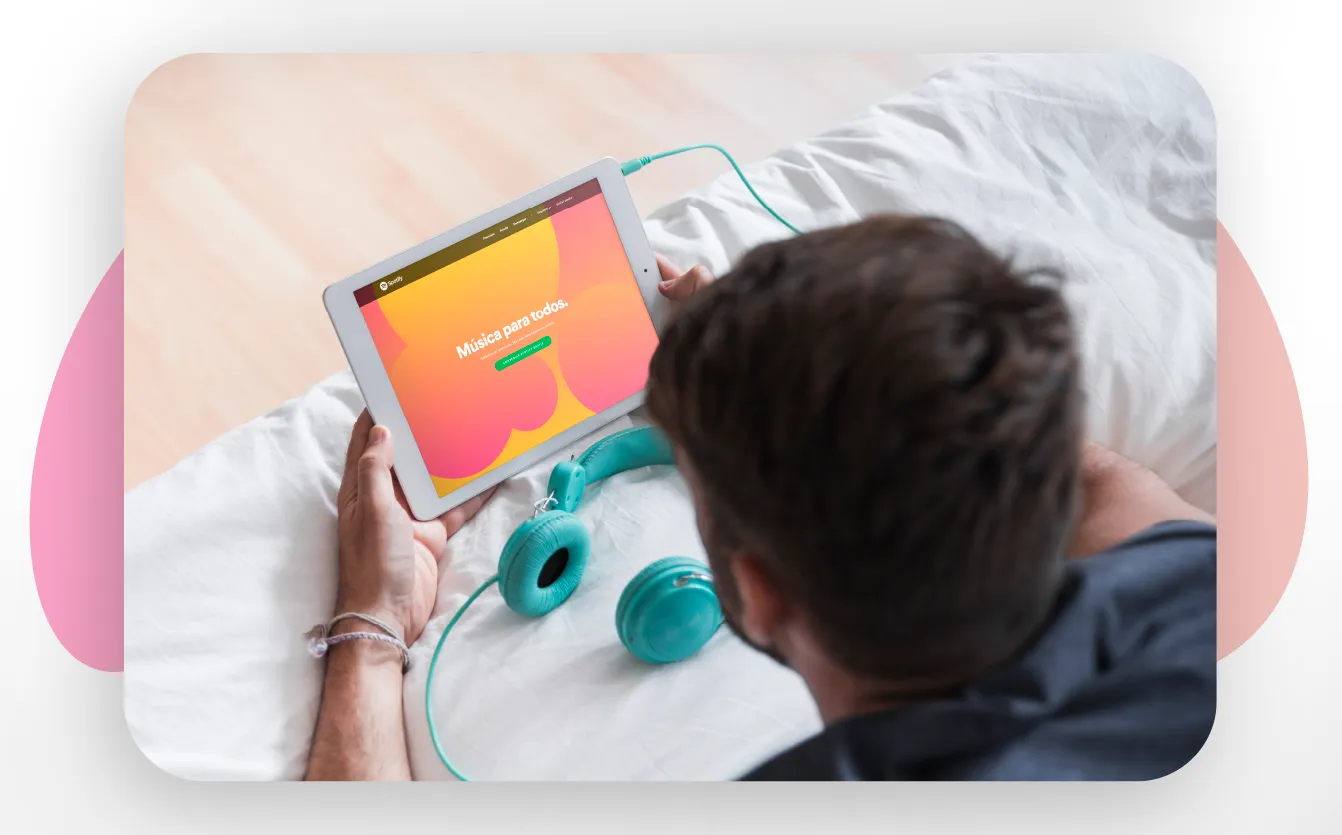
Large businesses, especially e-commerce giants like Amazon, can create personalized shoppable videos based on customer preferences and past purchases. By using data analytics, these businesses can serve viewers shoppable videos that feature products tailored to their interests. For example, if a customer frequently buys kitchen gadgets, they could be shown a shoppable video highlighting new kitchen tools, which are immediately available for purchase.
d. High-end fashion runway shows
Large fashion houses like Burberry or Prada can use shoppable videos to make their runway shows instantly shoppable. As models walk down the runway, viewers can click on the garments and accessories they like, pre-ordering the items directly from the show. This strategy taps into the luxury market’s sense of exclusivity while making high-end products immediately accessible to global consumers.
e. Exclusive previews for loyalty program members
Exclusive shoppable video content can be offered by big companies to their members. These videos could provide early access to new products or offer special discounts on items featured in the video. This creates a sense of exclusivity for loyalty members and drives more engagement with the brand.
f. Augmented Reality (AR) and virtual try-on experiences
Augmented Reality (AR) technology can be used to create virtual try-on experiences within shoppable videos. A beauty brand could create shoppable AR videos where viewers can see how different makeup products would look on their skin tone, then click to purchase the exact shades. This is likely to reduce customer dissatisfaction and returns.
g. Corporate Social Responsibility (CSR) campaigns with a charitable component
A shoppable video that promotes products with a charitable twist can also help the Corporate Social Responsibility (CSR) that a company supports. For instance, a video could highlight products where a portion of the profits is donated to environmental causes, and viewers can purchase those items directly while learning about the company’s mission.
Whether through live shopping events, personalized video ads, or interactive runway shows, larger companies have the resources to implement shoppable videos at scale, directly linking their content to sales, driving engagement, and taking the customer experience to the next level.
Why should you include video shopping in your strategy?
If you’re a business owner or marketer, you’ve probably noticed how fast the way we shop is changing. Customers aren’t just looking for products anymore—they’re looking for experiences and they remember how a post made them feel. Video shopping fits perfectly into this shift, offering a way to connect with customers on a deeper level.
The shoppable video content that converts viewers into buyers have an engaging hook and interesting storytelling
But why should businesses make video shopping a key part of their strategy? Let’s break it down.
1. Engaging content drives sales
People love videos. In fact, studies show that viewers retain 95% of a message when they watch it in a video, compared to just 10% when reading it in text. This makes video content incredibly powerful for showcasing your products. Whether it’s through live streams, tutorials, or product demos, video shopping allows you to show off your products in a way that’s both engaging and informative, leading to higher conversion rates.
2. Builds trust and authenticity
Video shopping helps build that trust by allowing customers to see products in action before they buy. It’s one thing to read about a product’s features, but it’s another to actually see it in use. Live streams and product video examples offer a transparent and raw look at your products, which can make customers feel more confident about their purchases.
3. Creates a personalized shopping experience
Today, personalization is key, and video shopping offers a way to make the shopping experience feel more tailored to every customer. Adding shoppable video content to your website like live interactions, Q&A sessions, and real-time feedback, businesses can address customer concerns directly, offer personalized recommendations, and create a shopping experience that feels unique to each viewer.
4. Enhances social proof
Whether it’s live streams, customer testimonials, or user-generated content, video gives your brand a platform to showcase real-life experiences with your products, which can really influence purchasing decisions.
5. Expands reach across platforms
With platforms like Instagram, TikTok, and YouTube making it easier than ever to integrate shopping features into video content, video shopping allows you to reach customers right where they are. You can tap into the massive audiences on these platforms and turn casual viewers into loyal customers.
By including video shopping in your strategy, you’re not just keeping up with trends—you’re creating richer, more engaging experiences that resonate with today’s consumers.
10 shoppable video content ideas for your marketing strategy
1. Shoppable reels
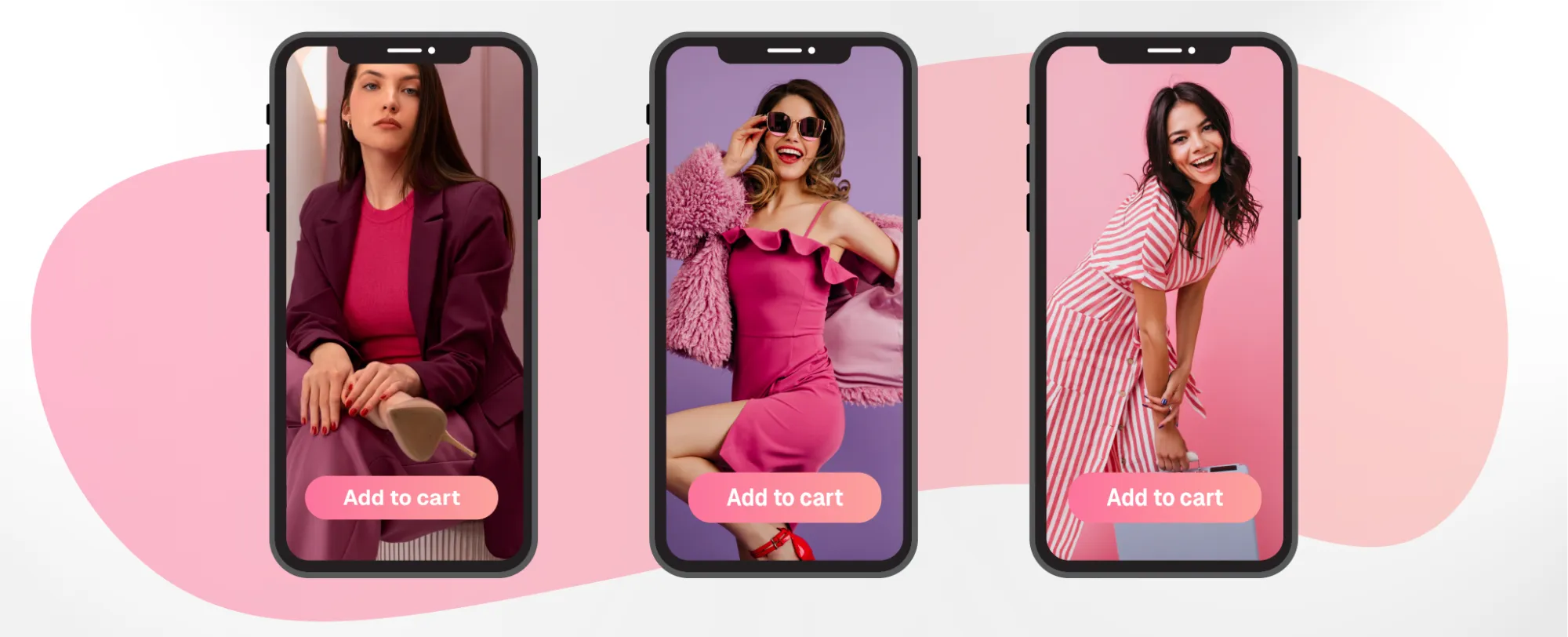
Those quick, catchy videos you see on Instagram are super engaging. Imagine if you could actually buy the stuff you see in those videos with just a tap. That’s exactly what Shoppable Reels let you do. They’re short, fun, and perfect for showing off products in a way that’s super easy for viewers to shop from.
When to use Reels
- New product launch: For a new launch, think of a reel as a mini commercial, but way more fun. For example, if you’re launching a new sneaker, create a Reel that shows it in action—maybe someone running in them, or styling them with different outfits.
- Behind the scenes: Give your followers a sneak peek into your world. Show how your products are made, who’s behind the scenes, or even how a typical day looks like. It makes your brand feel more human and real.
- Quick how-tos: Everyone loves a good tip. If you’re a beauty brand, show a quick makeup hack using your products. If you’re a kitchen brand, cook a new dish. Tag the products you’re using so viewers can buy them right away.
- Real customer stories: Share the stories of customers who love your products. It’s like word-of-mouth, but way more visual.
- During sales and events: Show what’s on sale, and make it super easy for people to grab those deals by tagging the products.
Tips for creating great shoppable reels
- Keep them quick and engaging. Aim for 15 to 30 seconds of impactful and interesting content.
- Make your reel stand out by using music, transitions, and effects. Creativity is key to catching viewers' attention and encouraging them to watch till the end.
- Show, don’t tell. Let viewers see how your product works, how it fits, or how it’s made.
- Use clear calls to action. Don’t forget to guide viewers on what to do next. Whether it’s “Tap to Shop” or “Swipe Up for More,” make sure it is clear and easy to follow.
- Highlight key features using text overlays or voiceovers. This helps viewers understand what makes your product special even if they’re watching with the sound off.
- Use popular trends and find creative ways to incorporate your products into these trends. This can increase the visibility of your reels.
Miraggio’s shoppable video success
Miraggio, a luxury handbag brand, used shoppable videos to really boost their online sales. They made it easy for people to click on the handbags featured in their videos and buy them directly without leaving the video. This made shopping super easy and kept viewers interested.
Mirragio uses reels as their shoppable video content to convert customers faster.
Results:
- Miraggio saw a 35% increase in revenue after they started using shoppable videos.
- They also had a 25% higher engagement rate compared to their usual videos.
- Conversion rates went up by 40%, meaning more people were buying directly from the videos.
2. Live Streaming
Ever found yourself glued to a live video, watching someone open the latest iPhone or try on a new outfit? That’s the magic of live stream shopping—it’s like hanging out with a friend who’s showing you cool stuff they just got, but with the added advantage of being able to buy it right then and there.
Live streaming allows brands to showcase their products in real-time, offering an interactive experience where viewers can ask questions, request demos and buy what they like during the streaming.
When to use live streaming for shopping
- Product launches: The real-time nature of live streaming builds excitement and creates a sense of urgency for new products.
- Q&A sessions: Host sessions where viewers can ask questions about the products. This not only provides valuable information but also builds trust with your audience.
- Influencer collaborations: Partner with influencers to host live shopping events. Influencers can draw their followers to the event, increasing reach and engagement.
Tips for a successful live shopping event
- Plan your content before going live. Create an outline, highlight key products, and structure your stream with an introduction, demos, customer interactions, and a closing segment.
- Interact with the viewers by asking questions, responding to comments, and using interactive features like polls or live Q&A sessions to build more trust.
- Create urgency with limited-time offers available only during the live stream. Use countdown timers to enhance urgency, driving quicker purchasing decisions.
- Use a quality camera and microphone to reduce background noise and ensure your voice is heard clearly. If possible, show products from different perspectives, giving viewers a complete view of what you’re showcasing.
- Test and prepare for glitches before going live. Have a backup plan in place, just in case something goes wrong.
- Follow up after the live stream, continue engaging with your audience by responding to comments, sending follow-up messages, and providing links to the products featured.
How Walmart used TikTok for a successful live stream shopping
Walmart partnered with TikTok for a live stream shopping event during the 2020 holiday season. TikTok influencers showed Walmart’s fashion line, where viewers could shop directly via TikTok.
Results:
- 7x more views than the average Walmart live stream, showcasing the potential of social media-driven live shopping.
- The event attracted over 10 million views and resulted in thousands of items being added to carts in real-time.
Partnering with TikTok, a platform known for its young and highly engaged user base, allowed Walmart to reach a broader audience, while offering a great customer experience that drives sales.
3. Stories
Stories are those quick, eye-catching updates you see on Instagram, WhatsApp or Facebook that disappear after 24 hours unless saved as highlights. Imagine seeing a Story about a new jacket, loving it, and being able to buy it instantly with just a tap. That’s what shoppable videos in Stories can do. They make it easy to go from “I like that” to “I need that” in just a few seconds.
When to use stories:
- Highlight new arrivals: Use Stories to give your audience a first look. You can show off new items, style them in different ways, and let viewers shop directly from the Story.
- Promote limited-time offers: The 24-hour lifespan of Stories adds urgency, making them perfect for time-sensitive deals. Add a countdown sticker to remind viewers that time is ticking.
- Boost engagement: Use polls, questions, or countdown stickers to encourage viewers to engage, and combine this with shopping options to convert that engagement into sales.
Tips for creating great shoppable stories:
- Keep the Stories short and digestible. Focus on making them visually engaging and straight to the point.
- Be creative with stickers to make your Stories more interactive and fun while subtly encouraging viewers to check out your products.
- Tell a story and take viewers on a quick journey—whether it’s the story of how a product is made, how to use it, or why it’s perfect for them.
- Experiment with different formats like photos, videos, boomerangs, and even GIFs. Keeping your Stories varied can make them more interesting to watch and increase the chances of viewers sticking around to shop.
Oceedee triples conversion with shoppable stories
OCEEDEE, a luxury footwear brand, has integrated stories directly into their website to create a more engaging shopping experience. These shoppable stories allow visitors to browse through visually appealing, bite-sized video content showcasing their products. As customers watch, they can easily click to learn more about each product and make a purchase, all within the seamless flow of the story.
OCEEDEE uses stories as their shoppable video content to create focus as highlights.
Results:
- They saw a 3x increase in conversion rate to 2.86% in the last 30 days.
- The stories attracted a considerable amount of attention, with 7,602 video clicks recorded.
Shoppable Stories are a powerful tool to connect with your audience in a way that’s both engaging and sales-driven.
4. Product unboxing videos
Imagine a customer eagerly orders something online, only to return it because it wasn't quite what they expected. It’s frustrating for them and costly for you. But what if your customers could get a real glimpse inside that box before they buy? That way, their expectations would be perfectly aligned, saving everyone the hassle.
That’s where unboxing videos help. They give a sneak peek into the product experience—everything from the packaging to the actual item—so your customers know exactly what to expect.
When to use unboxing videos
- Product launches: When you’re rolling out a new product, unboxing videos can build excitement and anticipation. Show off everything from the design of the packaging to the first look at the product itself. It’s a great way to give potential buyers a feel for what they’re getting.
- Limited editions or special releases: If you have a limited edition or a special version of a product, use an unboxing video to highlight what makes it unique. Show off the exclusive features, premium packaging, or any special bonuses that come with it.
- When introducing high-end or luxury items: An unboxing video can highlight the details and premium quality, making the expensive purchase feel more special and justifying the cost.
Tips for creating great unboxing videos
- Make the unboxing process enjoyable to watch. Pay attention to the details—how the box opens, how the product is revealed, and any extras like thank-you notes or freebies.
- Show every detail, from the outer packaging to the actual product. Capture the entire process and provide close-ups of important features or accessories included in the box.
- Engage with the audience throughout the video. Ask them what they think of the product, if they’ve tried it before, or what they’re most excited about.
- Avoid filler conversations to not lose the audience's attention. Aim to be thorough without dragging on too long—viewers should stay interested from start to finish.
How Milton used unboxing videos to increase their ‘Add to Cart’ by 450%
Milton used unboxing videos to give their customers a close look at their products before they made a purchase. By walking viewers through the unboxing experience, Milton made the buying process more transparent and engaging, helping customers feel more confident about what they were getting.
Milton using unboxing as shoppable video content is a brilliant way to build more trust in their products
Results:
- Saw a 450% increase in Add-to-Cart rates.
- Drastically improved product visibility and reduced returns.
- Gained customer trust through honest and detailed product showcases.
Unboxing videos are a way to build trust with your audience by showing them exactly what they’ll get. They bring the excitement of discovering something new right to your viewers, helping to build anticipation and confidence in your products.
5. Tutorial and demo videos
Tutorial and demo videos as shoppable video content are like how-to guides but with a twist. Imagine watching a step-by-step makeup tutorial where you can click on the exact lipstick or eyeshadow being used and buy it right then and there.
These videos not only teach viewers how to do something but also make it super easy to purchase the products being shown. It’s a useful and convenient combination of learning and shopping, making the experience both fun and functional.
When to use shoppable tutorial videos
- Product launches: If you’re introducing a new product, a tutorial can show customers exactly how to use it. For instance, a beauty brand could create a tutorial demonstrating a new makeup palette, with shoppable links to each product featured.
- Promoting bundles or kits: If you’re selling a bundle or kit, a tutorial video can show how all the items work together. For example, a workout kit can be featured in an exercise tutorial video where viewers can directly buy the bundle used in the video.
- Educational content: Use tutorials when you want to educate your audience on how to make the most out of your products. Whether it’s a fitness routine, a skincare regimen, or a tech setup guide, shoppable tutorials can help viewers get hands-on with your products.
Tips for creating great shoppable tutorial videos
- Keep it clear and simple by breaking down the steps into smaller chunks, and use clear visuals to guide the viewer. The simpler the tutorial, the more likely viewers will be to follow along.
- Talk to your viewers like you’re having a conversation with a friend to build trust. Share personal tips or tricks that make the tutorial feel more genuine.
- Highlight the benefits as you demonstrate each product. Let viewers see the product in action and understand why they need it.
- Use clear calls to action throughout the video, remind viewers that they can click to buy the products you’re using.
Lovechild by Masaba shot up conversion rate with tutorial and demo videos
Lovechild by Masaba, a popular beauty and wellness brand, used tutorial videos to show their products in action. These videos offer customers a guide on how to use their products, making it easy for viewers to see the benefits firsthand. As customers watch the tutorials, they can instantly click on the products being used and purchase them directly.
Lovechild by Masaba build tutorials into their shoppable video content to help customers and build a deeper connection
Results:
- Lovechild saw an incredible 5x boost in their conversion rate.
- The tutorials made it easy for customers to move from learning about the product to buying it, all within the same video.
Shoppable tutorial videos are a fantastic way to blend education and e-commerce, helping your audience learn something new while making it easy to shop for the products they need.
6. User-Generated Content (UGC) videos
Shoppable UGC videos are the next level of word-of-mouth marketing. Imagine watching a video where a real customer talks about their experience with a product—how it worked for them, what they loved (or didn’t love), and how it compares to other products they’ve tried. Customers trust the opinion of someone they can relate to.
Now, imagine that as they’re sharing their thoughts, your customers can click on the product they’re talking about and buy it right there. Shoppable UGC videos combine the trust and authenticity of human opinion with the convenience of online shopping, making it easier than ever for viewers to move from interest to purchase.
When to use shoppable UGC videos
- Building trust in competitive markets: In markets with lots of similar products, honest user-generated videos can set your brand apart. They provide social proof and show why your product stands out.
- Highlighting key features: UGC shoppable video content can help when you want to emphasize specific features or benefits of a product. Customers can talk about how those features made a difference for them, making it easier for viewers to see the product’s value.
- Addressing common questions: If your product often raises specific questions or concerns, then hearing another customer discuss how the product met their needs can be more convincing than any product description.
Tips for creating great shoppable customer review videos
- Keep it real by encouraging customers to speak naturally and share their real experiences—both the pros and the cons.
- Showcase videos from a variety of customers to appeal to different segments of your audience. Whether it’s different age groups, lifestyles, or needs, showing a range of experiences can help more viewers relate to the product.
- Make it easy to shop with clear and accessible shoppable links or product tags throughout the video.
- Reward participation to encourage more customers to create UGC by offering incentives like discounts, shout-outs, or entry into a contest.
- Mix up the format with close-ups of the product in use, before-and-after shots, or quick summaries of key points. This keeps the video dynamic and holds viewers’ attention longer.
Lea Clothing’s engagement boost with UGC
Lea Clothing shows how their customers use their products to make it very relatable to their audience
Lea Clothing Co., a fashion brand celebrated for its inclusive and stylish designs, has tapped into the power of shoppable user-generated content (UGC) to connect with their audience in a more authentic and engaging way.
By featuring real customers showcasing how they wear and style Lea’s clothing, the brand created genuine content that resonates deeply with its audience.
Results:
- Lea Clothing Co. experienced a 3x increase in customer engagement after implementing shoppable UGC into their strategy.
- They are able to build stronger, more personal connections with their audience, fostering greater trust and loyalty.
Shoppable customer review videos are a powerful way to connect with your audience by letting them hear directly from others who have already tried your products. By showcasing real experiences and making it easy for viewers to shop, these videos can build trust, answer questions, and drive sales—all at the same time.
7. Behind-the-Scenes (BTS) videos
Shoppable Behind-the-Scenes (BTS) videos are a unique way to pull back the curtain and show your audience what goes on behind the scenes of your brand—while also giving them the chance to buy what they see.
Imagine watching a video that takes you inside a photoshoot, a design studio, or even the factory where products are made. As you get a peek into the process, you can also click on the products featured in the video and purchase them instantly. These videos make the shopping experience feel more personal and connected, turning your customers into insiders.
When to use shoppable bts videos
- Campaign shoots: Show your audience the work that goes into a marketing campaign to build anticipation for what’s coming. Let them see the creative process, the team, and the effort behind every detail.
- Craftsmanship or manufacturing process: If your products are handmade or involve a detailed manufacturing process, BTS videos can highlight the craftsmanship and care that goes into each item. This adds value to your products and makes them more desirable to customers.
- Brand storytelling: Whether it’s a day in the life at your company, a look at how products are designed, or the journey from concept to creation, these videos make your brand feel more relatable and trustworthy.
Tips for creating great shoppable BTS videos
- Let your audience see the real, unpolished side of your brand to connect better with them. Show the challenges, the teamwork, the candid moments and the passion that goes into what you do.
- Highlight products naturally and make it easy to shop even though the focus is on the behind-the-scenes action. Use product tags or links to make it simple for viewers to click and buy without interrupting the flow of the video.
- Use good storytelling even though it’s behind-the-scenes content. Whether it’s the journey of creating a product, the excitement of a photoshoot, or the daily life in your office, the narrative should be interesting enough to keep the session engaged and interactive.
Everlane’s transparent factory tours
Everlane, a fashion brand known for being honest about how their clothes are made, has done a great job using behind-the-scenes (BTS) videos to connect with their customers. One of their best ideas was creating virtual factory tours, where they took viewers inside the places where their clothes are made.
In these videos, Everlane showed how each piece of clothing is carefully crafted, highlighting the quality and care that goes into their products. Viewers could click on the items being made and buy them right from the video.
Results:
- By showing how their clothes are made, Everlane earned more trust from customers who care about ethical production.
- The mix of storytelling and easy-to-click shopping links led to more people buying the featured items.
Shoppable Behind-the-Scenes (BTS) videos let your customers feel like they’re part of the process—and that connection can drive both loyalty and sales.
8. Brand story videos
Shoppable brand story videos are a powerful way to share the heart and soul of your brand while making it easy for viewers to shop your products. You can tell the story of how your brand came to be—whether it’s the inspiration behind your first product, the challenges you overcame, or the values that drive your business. Just by adding shoppable links to that story the viewers can buy the products that are a part of your journey.
When to use shoppable brand story videos
- Brand launches or rebranding: A brand story video can introduce your vision and mission to the world. It’s a great way to build an emotional connection with your audience from the start.
- Milestone celebrations: Use these videos to celebrate key milestones, like anniversaries or the launch of a new product line. Reflect on how far your brand has come, and invite customers to join in the celebration by shopping for the products featured.
- Highlighting social or environmental impact: If your brand is focused on making a positive impact—whether it’s through sustainability, fair trade, or charitable initiatives—use a brand story video to showcase this.
Tips for creating great shoppable brand story videos
- Be real and honest about your brand’s journey. Share your struggles, your successes, and what you’ve learned along the way. Authenticity resonates with viewers and builds trust, making them more likely to connect with your story and your products.
- Think about the narrative you want to share. Start with why your brand was created, highlight key moments in your journey, and end with where you are now.
- Make shopping feel natural as you tell your story. For example, if you’re talking about your first product, let viewers click to purchase it right when they’re hearing about it.
- Don’t be afraid to tap into emotions. Whether your story is inspiring, heartwarming, or even humorous, emotions are what make stories memorable. The more your viewers feel, the more connected they’ll be to your brand.
Suta increased engagement by telling their brand story
Suta, a beloved brand known for its beautiful handwoven sarees and sustainable fashion, deepened the connection with their customers by telling the story behind their products—highlighting the artisans who craft them, the inspiration behind their designs, and their commitment to sustainability. They also allow viewers to shop the products featured, creating an immersive and seamless shopping experience.
Results:
- Suta saw a remarkable 2x increase in customer engagement.
- The ability to shop directly from the story videos made it convenient for customers to purchase the products they felt connected to, driving both engagement and sales.
Suta’s success with shoppable brand story videos highlights the impact of combining storytelling with e-commerce. Shoppable brand story videos invite viewers into your world and show them what makes your brand special.
9. Interactive videos
Interactive videos are one of the most interesting types of shoppable video content. They are like the choose-your-own-adventure books of the video world, but with a shopping twist. These videos invite viewers to actively participate—whether it’s by clicking on different products, exploring various features, or making decisions that guide the storyline.
As viewers engage with the story, they can also shop for the featured products, making the experience not just entertaining but also convenient. It’s a way to turn passive watching into active shopping, all while keeping your audience hooked.
When to use shoppable interactive videos
- Product demos and tutorials: Interactive videos let viewers click on the features they’re most interested in or guide them through a step-by-step tutorial where they can shop for multiple items as they learn about it if the video features more products.
- Launching new collections: Use interactive videos to let viewers explore the different pieces in detail.
- Engaging marketing campaigns: If you’re running a creative campaign, interactive videos can make it more engaging. Imagine a video where viewers can choose how the story unfolds or pick which products the characters use—each choice leading to a shoppable moment.
- Virtual showrooms or tours: For larger items like furniture, cars, or even real estate, interactive videos can act as a virtual showroom. Viewers can explore different rooms, features, or models, clicking on the items they’re interested in.
Tips for creating great shoppable interactive videos
- Make it user-friendly with clear and easy to use buttons, so viewers can interact with the video without getting frustrated or lost.
- Keep it engaging by using a compelling storyline, eye-catching visuals, or a fun challenge to encourage viewers to keep clicking and exploring.
- Highlight shoppable moments clearly, with product tags or links that are easy to spot. Let viewers know they can shop without leaving the video.
- Personalize the experience by using branching paths to guide viewers to the products or features that interest them most. The more tailored the experience, the more likely they are to engage and shop.
Ted baker’s “mission impeccable” interactive video
In 2016, Ted Baker collaborated with Guy Ritchie, the famous director, to create a short, stylish spy-themed film titled “Mission Impeccable.”
Viewers could click on different elements within the film, such as the clothes and accessories worn by the characters, to learn more and purchase directly from the video. They could also unlock hidden content and participate in an interactive game that added an extra layer of engagement.
The campaign was heavily promoted across social media platforms, and the interactive elements made the video more engaging, encouraging viewers to explore and shop as they watched.
Results:
- Viewers spent more time watching and interacting with the content, thanks to the gamified elements and shoppable links.
- The ability to shop directly from the video led to a noticeable increase in sales of featured items by 26.5% to £321.9 million.
Ted Baker’s “Mission Impeccable” is a prime example of how shoppable interactive videos can elevate a brand’s marketing efforts. Shoppable interactive videos have the power to turn passive viewing into an active experience, keeping viewers hooked while seamlessly guiding them toward making a purchase.
10. Product comparison videos
Shoppable product comparison videos are like having a trusted friend break down the pros and cons of different products for you—only better, because you can click and buy your favorite one right then and there.
These videos line up two or more products side by side, showing viewers how they compare in terms of features, benefits, price, and more.
When to use shoppable product comparison videos
- Launching new products: A comparison video not only highlights the new features but also makes it easy for customers to see the value of upgrading or choosing your brand.
- Helping with decision-making: If your customers often ask, “Which one should I buy?”, a comparison video can be a lifesaver for them. These videos are perfect for helping customers decide between similar products or differently priced products faster.
- Educational campaigns: They can be particularly effective for explaining why a more expensive option might be worth the investment, or why a more affordable option offers great value for money.
Tips for creating great shoppable product comparison videos
- Clearly highlight the strengths and weaknesses of each product. If one product is more expensive, explain why, and if another is more basic, show what makes it a good choice for budget-conscious buyers.
- Show the products side by side to make the comparison easy to follow. Use split-screen visuals, charts, or direct feature-by-feature breakdowns so viewers can see exactly how the products differ.
- Highlight key differences whether it’s performance, design, durability, or price, make sure you’re comparing the features that will help viewers make a decision.
- Adding snippets of customer reviews can add credibility to your comparison. Hearing from real users about why they chose one product over another can help sway undecided viewers.
Samsung’s galaxy smartphone comparison shoppable video
Samsung created a shoppable video comparing different models of their Galaxy smartphones to help consumers quickly understand the differences between models like the Galaxy S21, S21+, and S21 Ultra. The comparison highlighted aspects such as camera quality, screen size, battery life, and price, providing a comprehensive look at each model.
The video presented each phone side by side, with clear visuals and narration explaining the key features of each model. Viewers could see detailed comparisons, such as the differences in camera capabilities or display technology.
The video was featured on Samsung’s website and promoted through their social media channels, reaching a wide audience of potential buyers.
Results:
- The video helped clarify the differences between similar models, making it easier for customers to decide which phone was the right fit for them, reducing decision fatigue.
- By integrating shoppable links directly into the video, Samsung saw an increase in the number of viewers who made a purchase after watching the comparison.
Samsung’s use of shoppable product comparison videos shows how effectively product comparison videos can help customers by offering a clear, interactive comparison of the pros and cons of any products. This makes it easier for viewers to choose the one that best fits their needs—while also making it convenient for them to buy it on the spot.
Shoppable videos are changing the way brands connect with their customers by making shopping more fun, interactive, and easy. Whether it’s a tutorial, a behind-the-scenes peek, a product comparison, or real customer stories, these videos let viewers learn about products and buy them right on the spot.
By using shoppable videos, brands can show off their products in a way that feels personal and engaging. It’s not just about selling—it’s about telling a story, solving a problem, or sharing an experience.
Try Whatmore.ai for your shoppable video content to build stronger connections with customers and make it easier for them to choose and buy what they love.
A Shoppable video brings growth to most businesses, no matter the size. Using Whatmore, you can create your videos shoppable within minutes and start increasing your conversion. Try it for free today!

